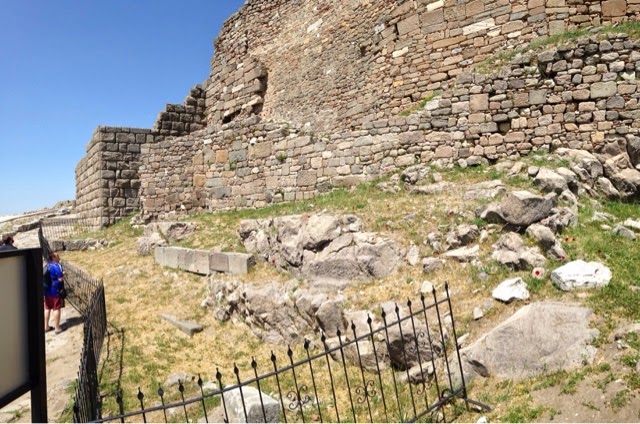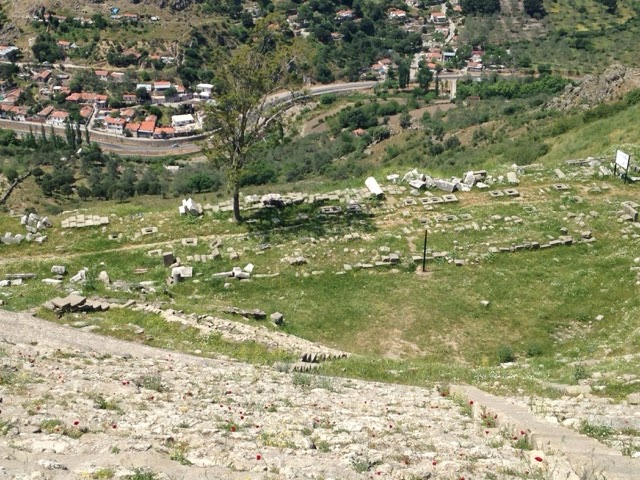Unless you are Michalis, the city of Pergamon is only accessable by cable car, as it is built into the side of a mountain. Mythologically, the city was founded by Hercules' son Telaphus. In actuality, the city fell under Greek rules under Alexander the Great, then passed into the hands of one of his generals Lisamokus after his death in 334 BC. Finally in 133 BC the city was giving the the Roman Empire formally after King Attalus III made a pact with the emperor, saying he would give the city to the empire after his death as long to protect the city from unnecessary invasion (The Romans could easily take the city at any time). For these reasons, there are many elements of both Hellenistic Greek and Roman structures on the site.
This is a model of what archelogists believe the city looked like at its peak during the Roman era. The all white structure in the middle left is the Temple of Zeus. This temple was originally excavated, shipped, and rebuilt by German archeolgists under the reign of Kaiser Wilhelm II and it currently sits in the Archeological Museum in Berlin (the fountain the Germans gave to the Sultan during the 1880s still sits in the ancient hippodrome in Istanbul (I believe it is in the Day 2 post).
This shot nicely shows the differences in technology between the Greeks and Romans. On the far left, the walls are built of solid limestone, cut and shaped to fit in perfect blocks without any adhesive. However, by the time the Romans came along, they had developed the correct proportion of incredients to make concrete, so they were able to make walls out if any local rock they could find, sometimes including the pieces to broken statues or buildings, and not having to worry if the wall would remain standing.
This whole in the ground with this arch and rock "arm" in the middle was a Roman water cistern. Roman surveyors were tasked with finding an adequate water supply and determining if the source of the fresh water spring was high enough to reach the city via an aqueduct, a though built at the top of a massive stone structure to carry the water to the city. This one however seems to be used only to correct rainwater, as no other pipe seems to be coming in or out of it.
The remnants here are of the Temple of Athena very close to the city center. This building had the traditional basilica, or stoa if you are speaking Greek, set up with onevcovered aisle on either side and a larger aisle in the middle where the cukt statue of Athena originally stood. See the olive tree in the middle of the ruins? This is a symbol of Athena as well, since legend said that Athena granted the citizens an olive tree when they were selected with god or goddess would be the patron of the city. Once the people realized the fruit could be used to make oil, heal, heat, and light their homes (and of course eat), they immediately selected her. Sort of a cool piece to the puzzle that is Greek mythology.
Here are the ruins of the Temple of Hadrian at the top of the might mountain of Pergamon. Apparently, Hadrian took office in Rome as a direct result of the actions of a previous emperor, Thadgen, who had originally commissioned the building's construction. Nowadays, you can still see the corinthian capitals of the columns and notice the ionian shape from each base.
See the circle of trees in the middle and the row of cyprus trees just behind it with a row of columns connecting the two? These two structures were the ancient medical school and hospital of Pergamon. The practice of medicine in the Hellenistic period is a result of the courage of Galen, a scientist from here looking to learn more about the human body by performing autopsies in human corpses, a practice that forced him out of the city to Izmir where there was a gladiator training center (and no shortage of dead bodies). Now we thank Galen for his work in human anatomy and embrace new forms of technology to learn how our body functions.
This is by far the steepest theater I have ever seen... This is becausethe Greeks were looking to save a much space for the Temple of Zeus as possible (which stood directly above it). Had they decided to cut more into the hill and shallow out the theater, this would not have been possible. This theater is also different because the Greeks only a stoa behind the orchestra where the cast and set would be located, not a stage like in the Roman form. To compensate, the Romans drilled holes in multiple places in the stoa to build a temporary stage structure (likely made of wood), to maintain the tradition of the Roman theater. Also, since this structure was not originally Roman, marble seats were not used here, whereas local limestone seats were constructed.
Here is the photo of the foundation of the ancient stoa which has since been destroyed by earthquake activity.
Dionisis, the Greek god of theater and wine, frequently had temples and cult worship centers very near the theaters, and this is no exception. This structure often held acting contests where young actors (and those that consumed a good amount of Dionisis' blessing) would compete to entertain the crowd. Those that completed this task most effectively would win a goat, which may be the origin of the word 'theater' in English.
There are rows and rows of these columns, with others running perpendicular to these, beneath the Temple of Hadrian. Since the city was built on the side of a mountain, a platform with a substructure beneath had to be constructed to support the hundreds of tons of marble.
Just like in Ephases, the Library of Permamon sits adjacent to the Temple of Athena, the goddess of wisdom. Here, more than 90,000 books are alledged to be housed here at some point. Interestingly, the history of parchment paper also has its beginnings here. Since this library threatened the to become the largest in the world, passing Alexandria, the Egyptian government forbade the trade of papyrus paper to the city. So, the residents took to making paper out of animal skin, boiling it in olive oil, stretching it, cutting it into rectangles, and binding them into books with glue. Just another advance in ancient technology!
Ah, the Trojan Horse. According to legend (and maybe reality), the horse was given by the Greeks to the Trojans after nine years of brutal fighting over the city. Traditionally, horses like this were dedicated to Poseidon, Greek god of the sea. Thinking that refusing this massive horse would essentially snub the gods and result in horrible earthquakes (that likely did harm the city leading to its destruction), the Trojans accepted the gift into their heavily armed city walls. However, Greek soldiers were hidden inside, ready to take the city and end the reign of the Trojans. Whether this is true or not has been debated for the last few thousand years and may never be answered completely.
These are the city walls from Troy VI, the sixth layer (from the bottom) of the excavation dated somewhere around 1300-1200 BC. Notice that these walls are not straight up and down; instead they are angled inward. This was done purposefully, as this style of wall-building was much more likely to survive an earthquake than a vertical wall.
These two pictures show the original dobe mudbrick walls and rock foundations of the homes of Troy more than 5000 years ago. In the top photo, you can see a large white screen covering the area. This allows guests to understand how deeply these walls were buried in the earth, as the roof shows the ground level at the beginning of the excatation. It also protects the walls from further collapse.
Another site, another earthquake resistant home! If you notice, the stones making up the foundations are slanted instead of horizontal, meaning they are able to withstand the violent thrashing an earthquake would bring.
This ramp could be very famous if the whole story of the Trojan War is true. There is a hole to the left of this ramp that leads up to where the king's palace was located. This hole supposedly contains gold jewelry belonging to Helen, wife of the king's youngest son Paris who was kidnapped to Sparta following the war. Again, some of this is speculation based on Homer's famous poem, the Iliad.
Archeologists discovered several skeletons of animal bones in the area of this structure. From that and the flat table within the room, they determined this was a temple used for animal sacrifice to one of the Greek gods. However, no one is really sure which one it is.
The Bouleuterion and Oreion were both combined in this area. So, city council meetings during the Greco-Roman rule and small concerts for less than a few hundred people were held here (we aren't exactly sure how many since the structure has been damaged due to earthquake activity.
Hi Mom!!!!!
And now for the HIGHLIGHTS!
A big thank you to Dallas for her presentation on Pergamon. Great job!
Another big thank you to Liz for her presentation on the City of Troy. Well done!
This little girl at a rest stop made friends with Fatima, but unfortunately got a little too excited and bashed her face into the glass in front of the shop. Funny, but kinda sad too...
ECGT signing off!
























Hi Brandon. Love you!!!!
ReplyDelete